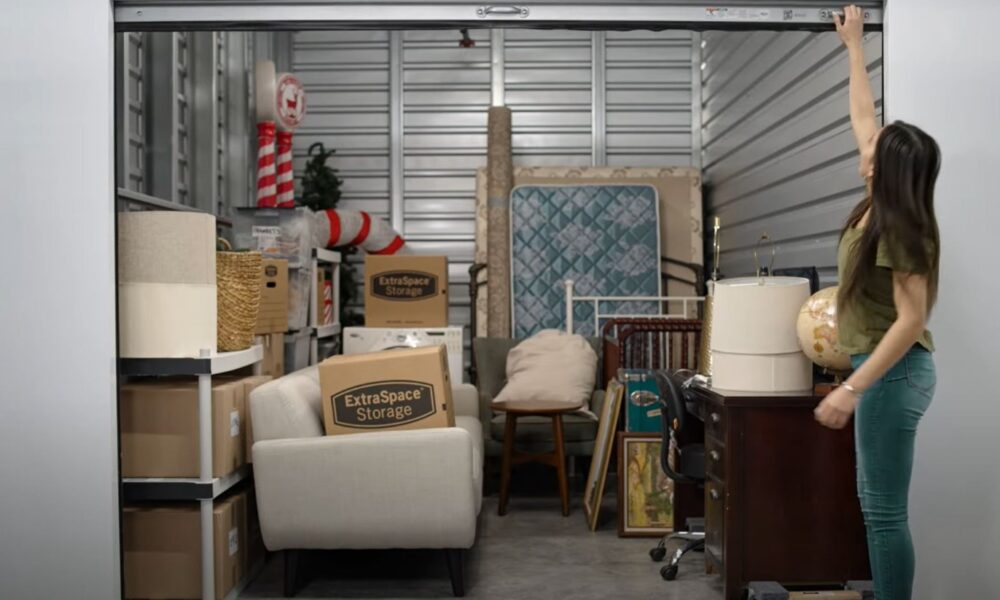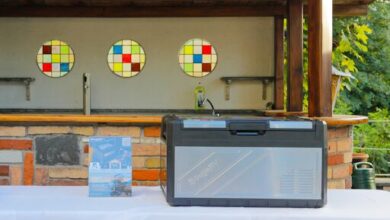How to Estimate the Right Storage Unit Size You Need

Whether you’re facing a mountain of boxes during your move, need a place to stash seasonal decorations, or have outgrown furniture, you might be downsizing your living space but aren’t quite ready to part with your valuable belongings. In such situations, off-site storage can be a lifesaver.
With convenient options, storage units come in various sizes to accommodate your extra stuff. However, finding the perfect fit—from compact lockers to expansive rooms, along with securing storage unit insurance—can feel overwhelming.
This comprehensive guide cuts through the confusion and provides a step-by-step method for estimating your exact storage unit size needs. Say goodbye to wasted space (and money!) and welcome a perfectly sized storage solution!
5 Steps to Estimate Your Storage Unit Size Needs
Choosing the right self-storage unit size is all about finding balance. You don’t want to be cramped and struggling to fit everything in, but renting a unit that’s much larger than you need means wasted space and, more importantly, wasted money. The difference in pricing between a small and medium storage unit can easily exceed $1,000 annually, so beware.
Before renting, equip yourself with a simple 5-step approach to precisely estimate your storage needs. This guide will help you choose the most cost-effective unit size for protecting your belongings in storage. Follow along and save yourself hundreds of dollars on self-storage solutions.
1. Take Stock of What You Need to Store (And Avoid Overspending)
Every square foot counts. Before looking for storage unit sizes, get a clear picture of your belongings. This initial step can save you significant money down the line. Many people end up renting units larger than necessary because they haven’t assessed what actually needs to be stored.
Be critical—are there items you can sell, donate, or recycle? Sentimental or irreplaceable belongings deserve secure storage solutions, but for everything else, consider whether it’s more cost-effective to replace them. By focusing only on what truly needs storage and following effective decluttering tips, you can significantly reduce the size of the unit you require and make substantial savings on your rental fees.
2. Create a Detailed Inventory: Map Out Your Storage Needs
Now that you’ve decluttered and identified your essential storage items, it’s time to create a detailed inventory. This serves two important purposes:
- Firstly, it provides a clear picture of your storage needs.
- Secondly, it becomes a valuable reference point for accessing stored items in future or claiming storage unit insurance.
When creating your inventory, don’t just jot down a vague list. Instead, imagine yourself building a virtual map of your storage unit. List each item you plan to store, including its dimensions (length, width, height) and any particular storage requirements (fragile, must be kept upright, etc.). This way, you’ll have a better understanding of the total storage space you’ll need.
For example, instead of simply listing “twin bed,” your inventory might detail “Twin size bed frame (L 78″ x W 39″ x H 38″)” and “Twin size mattress (L 75″ x W 38″ x H 10”). This detailed approach allows you to accurately calculate the cubic footage required and ensure adequate coverage with storage unit contents insurance.
3. Categorize by Size: Maximize Storage Efficiency
With your detailed inventory in hand, the next step is to categorize your belongings by size. This simple self-storage solution maximizes the space within your chosen unit. Group similar-sized items together—large furniture like couches and bookshelves in one category, and boxes and smaller appliances in another.
By categorizing by size, you can visualize how your belongings will fit within the storage unit. For instance, bulky furniture pieces like dressers can be placed against the walls, while smaller boxes can be stacked efficiently to fill any remaining gaps. This strategic organization ensures you’re not renting more space than you need.
Bonus Tip: While creating your inventory, note any oddly shaped items that might require special placement considerations within the unit.
4. Consider Stackability: Smart Space-Saving Techniques
Now that you’ve categorized your belongings by size, let’s explore how to maximize storage capacity within your unit. Many items can be stacked strategically to create additional usable floor space.
For instance, sturdy boxes can be stacked high to create a vertical storage area for lighter belongings. Furniture can also be optimized for stacking—consider removing table legs or disassembling items to create a more compact storage configuration.
Pro Self-Storage Tips:
- When stacking furniture, prioritize safety and stability.
- Place the heaviest items on the bottom and lighter items on top.
- Avoid overloading any single piece to prevent damage.
5. The Walkthrough Method: Putting It All Together
Now that you’ve categorized your belongings by size and considered stackability, it’s time to put everything together with the “Walkthrough Method.” This step-by-step technique goes beyond simply measuring your items; it helps you visualize the functionality of your storage unit.
- Space Allocation: Using your inventory list, allocate space for each category of items within your unit. Place furniture against the walls, stack boxes efficiently, and utilize vertical space for sturdier items.
- Accessibility Assessment: If you plan on infrequent access, you can pack your unit more tightly to maximize storage capacity. However, if you need to access specific items regularly, leave an aisle down the middle of the unit for easy access. Also, consider the size of doorways and hallways in the storage facility—will they accommodate bulky furniture or boxes you might need to move around?
- Climate Control Consideration: As you perform your inventory, watch for items that might be damaged by temperature swings, high heat or cold, moisture, and humidity. This includes delicate items like artwork, photographs, photo gear, and important documents. A climate-controlled unit can help maintain a consistent temperature and humidity range. For the items that matter most, consider climate-controlled storage and insurance to keep your belongings in optimal condition for generations.
The “Walkthrough Method,” with its easy accessibility approach, ensures a storage unit that maximizes space, allows trouble-free access to stored items, and protects belongings.
Small, Medium, Large – Choosing The Right Storage Unit Size
After you measure everything, it’s time to translate your estimated needs into one of the three storage unit sizes: Small, Medium, or Large. While storage facilities offer insurance for storage units, it’s surprising how much a unit can hold. Every facility offers a range of storage unit sizes, but they all boil down to these three categories. Understanding these categories, their capacities, and the proper storage unit dimensions will help you choose the most suitable unit for your belongings.
1. Small Units (4×5 – 5×5): Ideal for Minimalist Storage Needs
Square Footage: This category ranges from a compact 20 square feet (perfect for a 4×5 unit) to 100 square feet (accommodated by a 10×10 unit).
Good For: Small apartments, dorm rooms, or seasonal items tucked away for later use. These units comfortably hold a collection of boxes, a futon for occasional use, or even smaller furniture pieces.
Example: Imagine a college student heading home for the summer. A 5×5 unit provides the ideal space for storing a few boxes, a mini fridge, and perhaps a disassembled twin bed – everything a student needs to return to in the fall. This size unit is also great for storing off-season items like holiday decorations when not in use.
Pro Tip: Don’t underestimate the vertical space! Many small units are 8 feet tall, allowing you to stack boxes efficiently and maximize storage capacity.
2. Medium Units (5×15 – 10×15): Middle Ground for Apartments and Homes
Square Footage: Medium units range from a manageable 50 square feet (think 5×10) to a more spacious 150 square feet (accommodated by a 10×15 unit).
Good For: Storing the contents of a full bedroom, including furniture, washer, dryer, or other appliances, or everything you might find in a small apartment.
Examples: A 10×10 unit perfectly fits the furniture in your living room and bedroom. However, if you plan on storing appliances alongside your furniture, it might feel a little cramped. Consider a 10×15 unit for extra breathing room, which can comfortably hold furniture from a 3-bedroom house.
3. Large Units (10×20 – 10×30): Ideal for Spacious Storage Needs
Square Footage: Large units offer ample storage space, ranging from 200 square feet (10×20) to 300 square feet (10×30).
Good for: A large house with a garage overflowing with furniture or a business that requires storing inventory. Do you need a place to store entertainment centres or fridges? Large units are the answer!
Example: A 10×25 unit would comfortably hold furniture from a large 5+ bedroom house, with plenty of space left for a garage full of tools and equipment. This size is also ideal for commercial businesses that need to store inventory or receive deliveries within the unit.
Exploring Additional Storage Options
While small, medium, and large units cover the most common storage needs, other options are available depending on your specific situation.
Storage Lockers
These compact spaces are budget-friendly for storing seasonal items or infrequently accessed belongings. Perfect for holiday decorations, out-of-season clothing, or other miscellaneous items, storage lockers offer affordable and secure storage solutions to free up space in your home.
Here are some of the benefits of using storage lockers:
- Cost-Effective: Storage lockers are significantly cheaper than renting a full-sized unit.
- Ideal for Seasonal Items: Free up space in your home for seasonal items you don’t need year-round.
- Secure Storage Solutions: The facilities offer security measures and storage unit protection plans to keep your belongings safe.
Vehicle Storage
Some storage facilities offer designated spaces for vehicle storage. This can be a great option for motorcycles, off-season boats, trailers, or other vehicles you don’t use year-round. Be sure to inquire about size limitations and any specific requirements for vehicle storage.
Time To Take Action!
A perfectly sized unit means no wasted space, easy access to your belongings, and peace of mind knowing everything is safe and secure. While securing the ideal storage space, don’t forget to protect your belongings with storage unit insurance. Unexpected events can happen, and having the right insurance for valuable items in storage provides additional peace of mind. Check out Storage Protectors for a comprehensive storage insurance plan and learn more about safeguarding your stored goods.
FAQs
1. How should I pack my unit to save space?
Packing your unit tightly can be a great strategy for saving money on storage costs, especially for longer-term rentals. However, this approach is ideal only if you won’t need frequent access to your belongings. If you anticipate needing to access items regularly, consider leaving an aisle down the middle of the unit for easier navigation.
2. How can I access stored items in a tightly packed unit?
Utilizing free-standing shelves is ideal for maximizing space in your unit while maintaining accessibility. Shelving allows you to stack boxes and belongings vertically, creating a walkable space to access items at the back of the unit.
3. How do I get extra space for future storage needs?
When estimating your storage unit size, it’s wise to consider adding a space buffer. This “future-proofing” approach ensures you have room for additional items you might acquire, preventing the need to upsize your unit later.
4. How can I optimize the storage space within my unit?
Here are some pro self-storage tips for maximizing space and efficiency:
- Space-saving containers: Invest in stackable containers and boxes to maximize vertical space utilization.
- Furniture disassembly (if feasible): Disassembling furniture pieces, especially large items, can significantly reduce their storage footprint. Reassemble them when you need them again.
- Fragile items: Allocate extra space to ensure proper packing of fragile items to prevent damage during storage.
5. Should I consult the storage facility staff for help?
Absolutely! Storage facility staff members are experts in space optimization. They can walk you through the facility, offer personalized recommendations based on your specific inventory needs, and explain affordable storage insurance options. Feel free to consult with them to ensure you only pay for the right storage unit size for your belongings.
Read More From Techbullion And Businesnewswire.com





